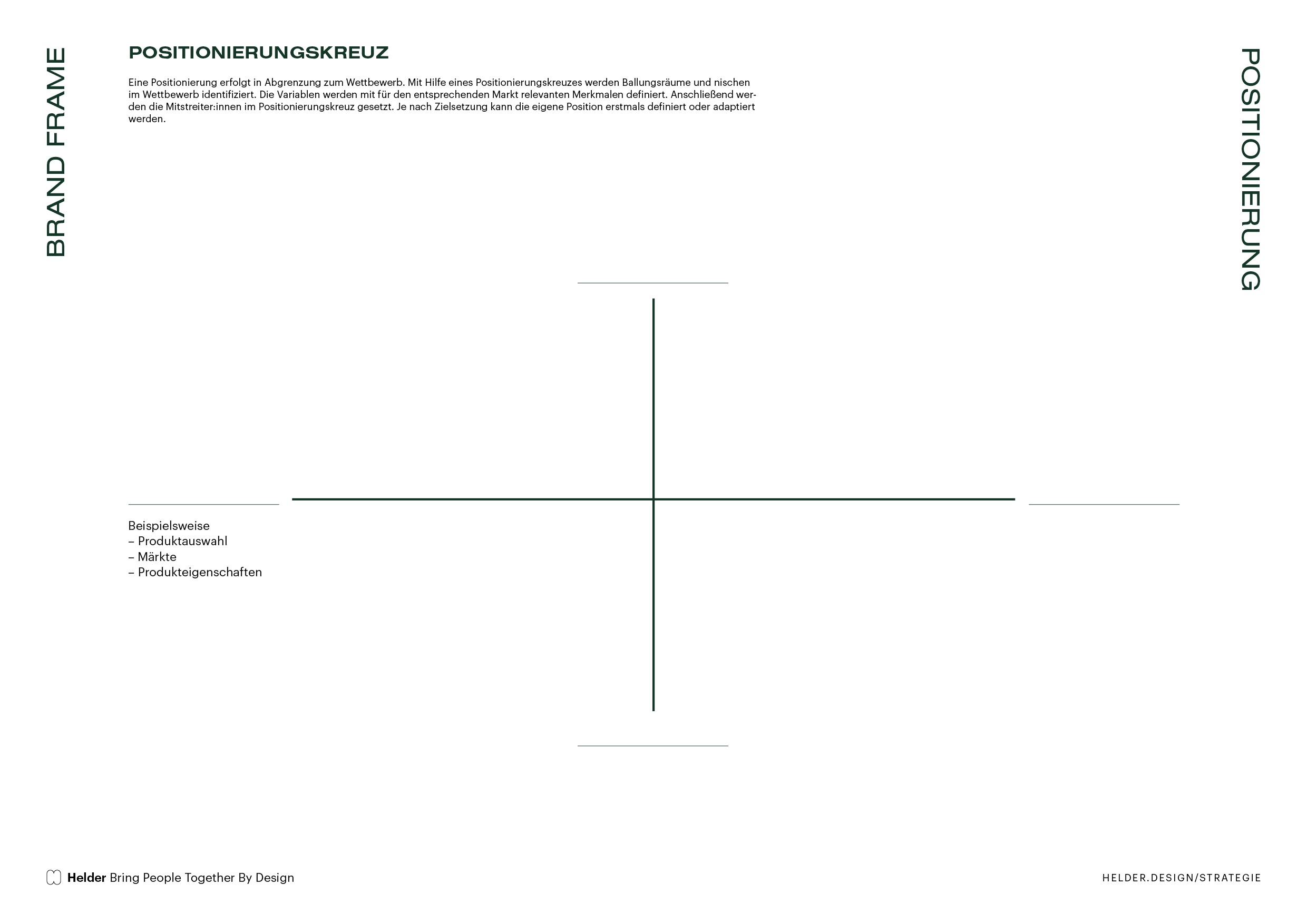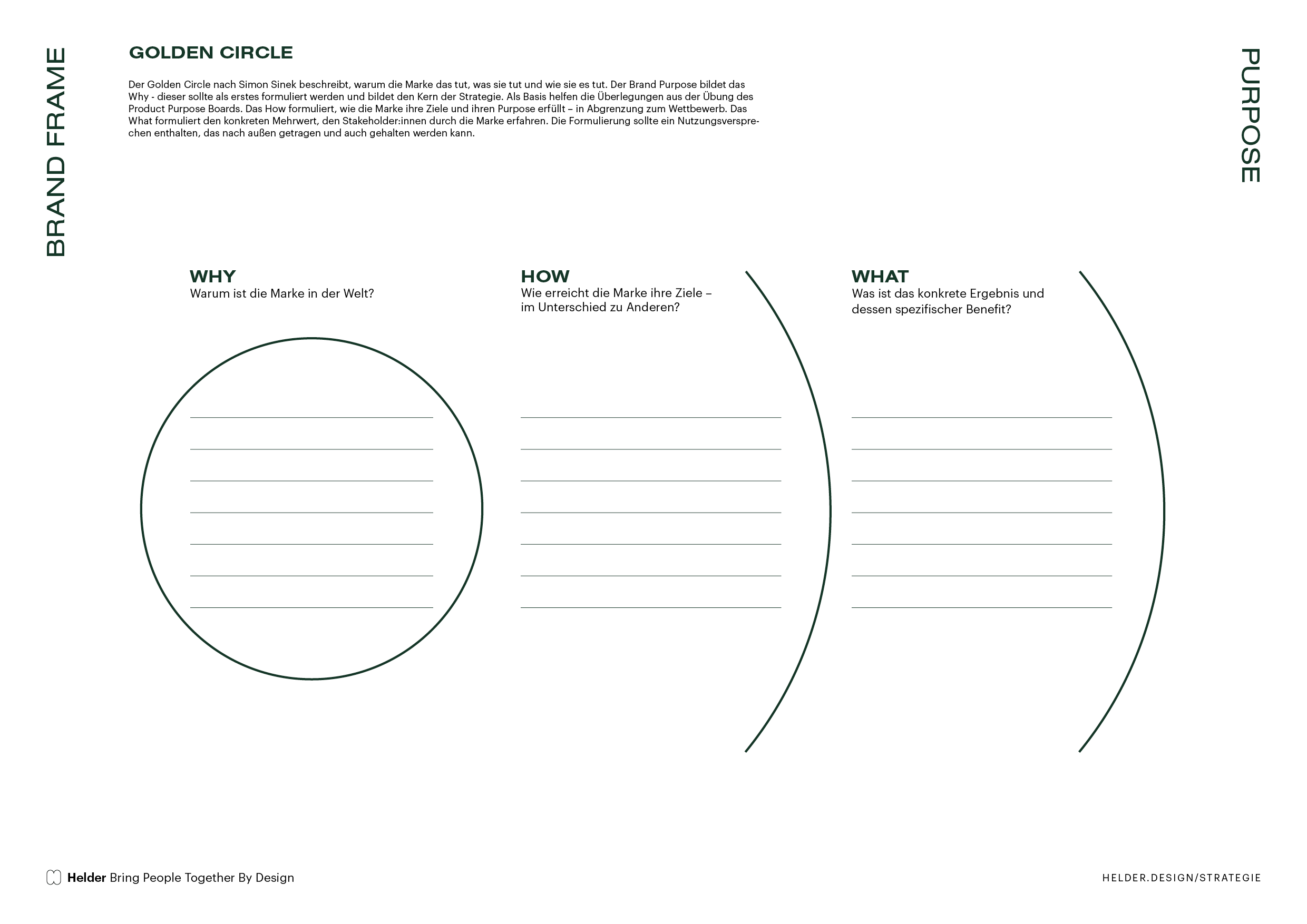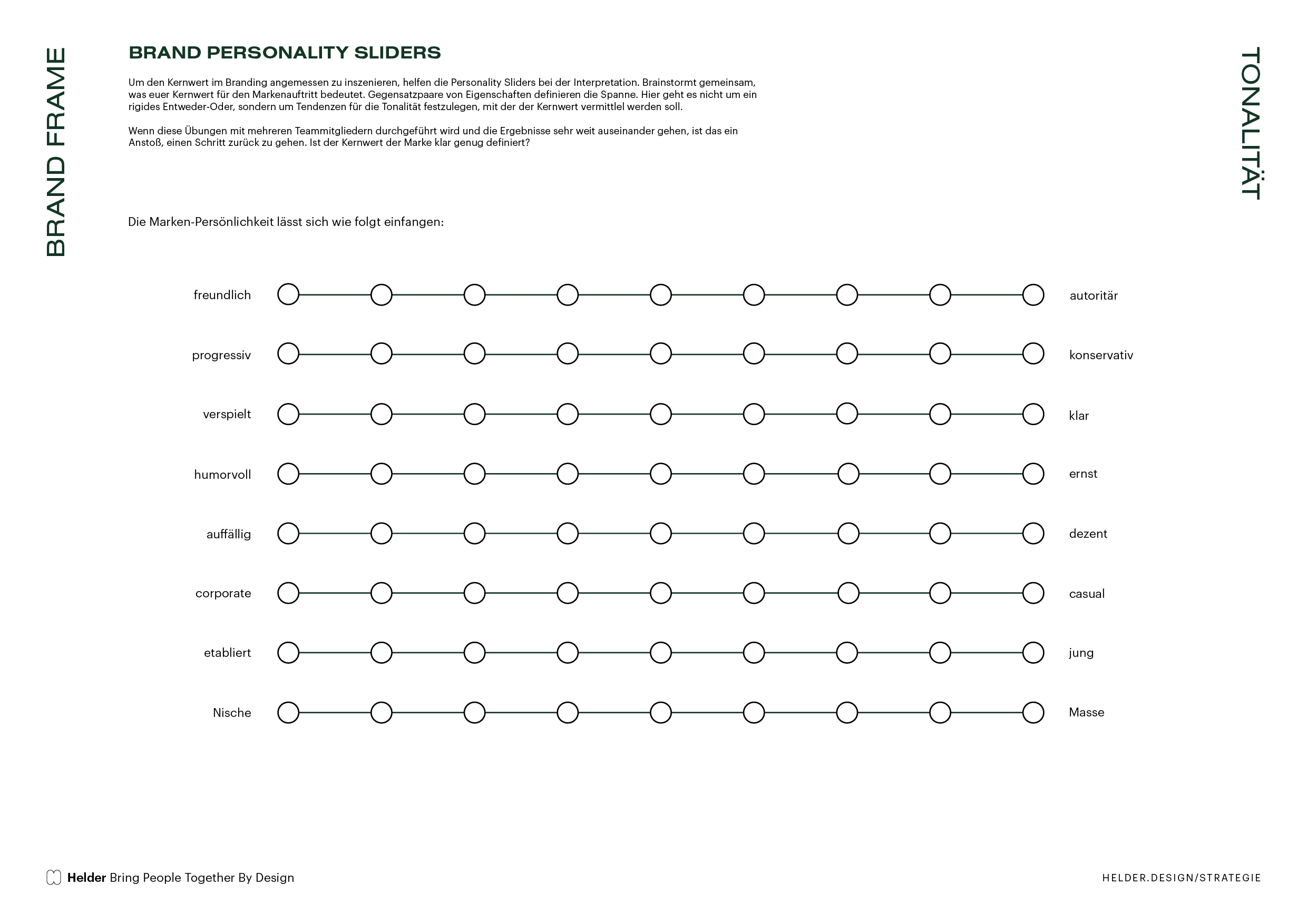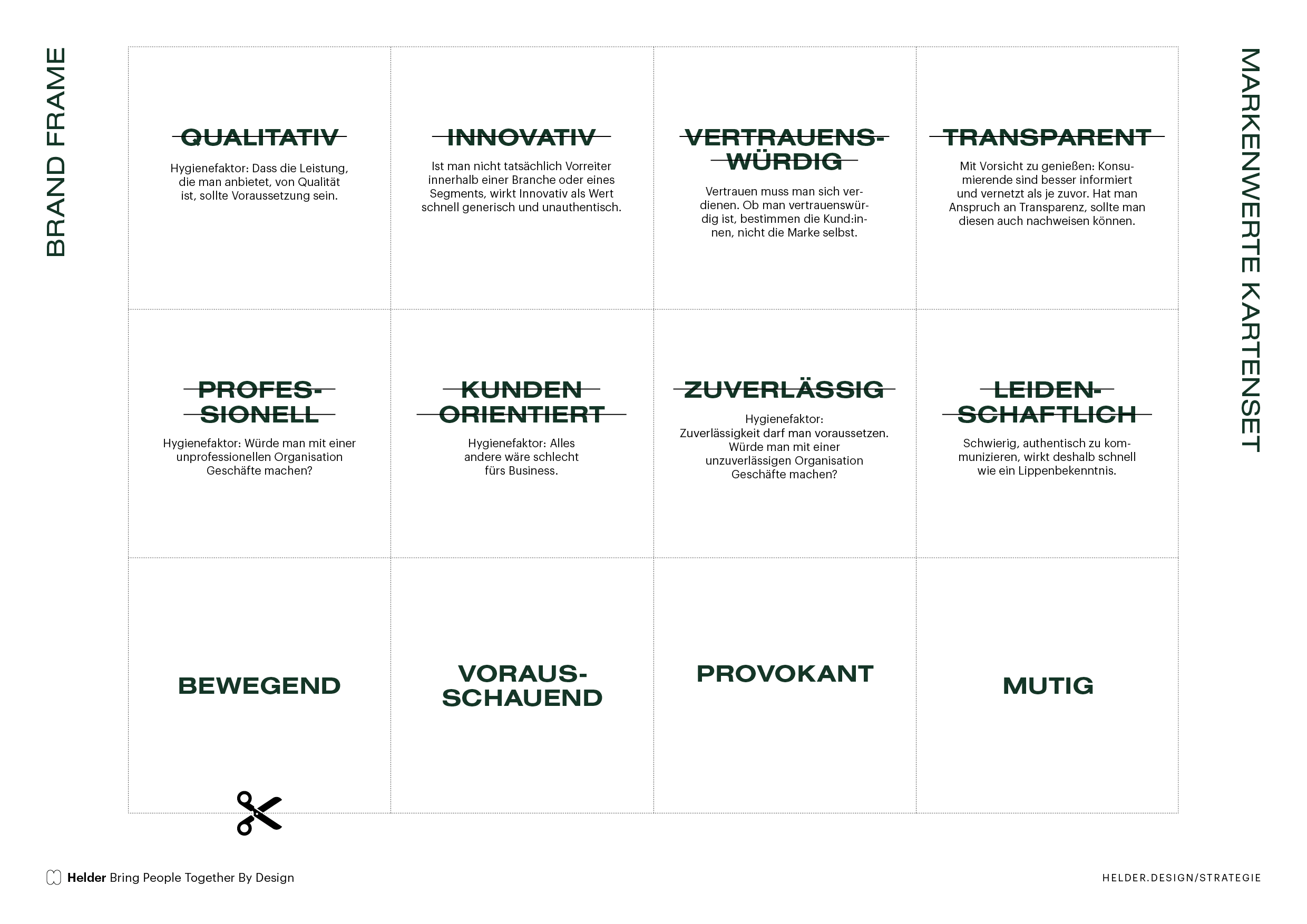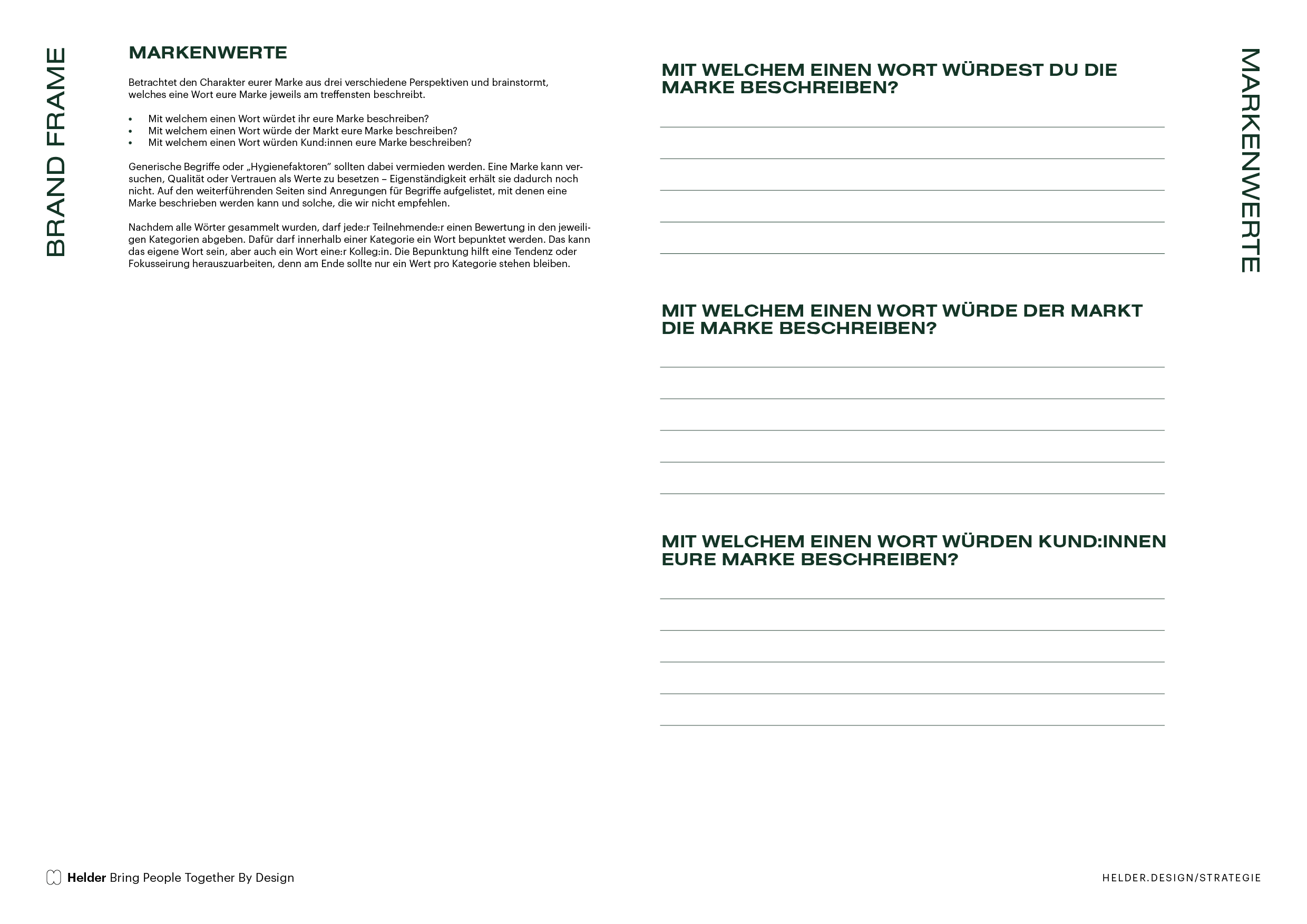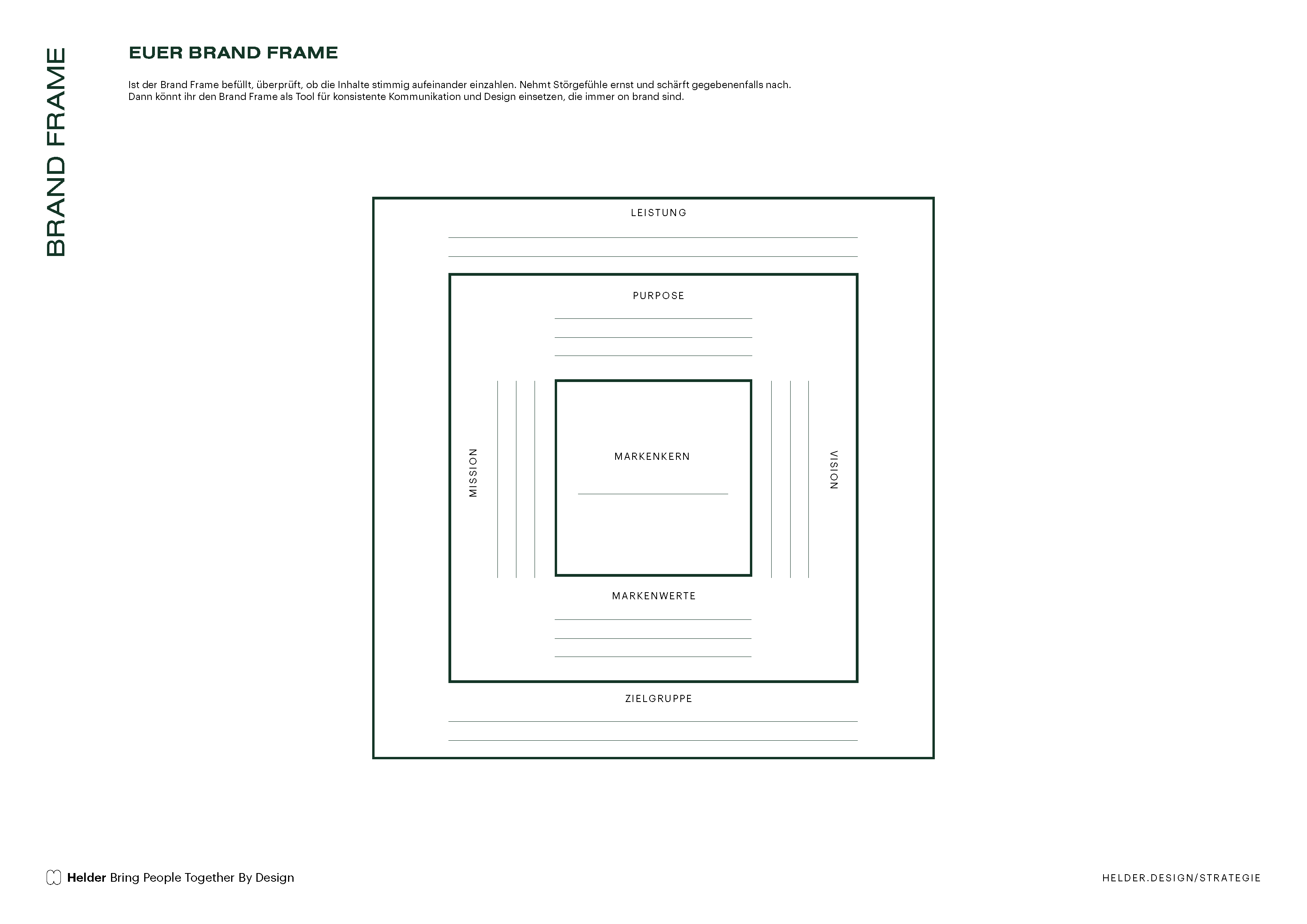The Brand Frame® as a Basis for Strategic Brand Design
While the company’s products and services continue to evolve on a daily basis in order to develop and maintain a competitive edge, this often does not apply equally to the brand. For the same reason, decision-makers often experience unfamiliar uncertainty when assessing the new appearance of their brand.
One question that we as a branding agency hear from customers again and again is:
And what do I do if I don’t like the design?
The question is understandable, because theoretically the design possibilities are almost unlimited. In practice, however, it is less a matter of individual taste than of the Brand Design expressing the brand essence and arousing the right associations in the target group. Brand design is the visual expression of the brand identity. It is there to convey a sense of what a brand stands for.
Bringing people together who share attitudes and values
As a strategic design partner, our purpose is to use design and messaging to bring people together who share attitudes and values: Sales teams with customers, start-ups with investors, employers with dedicated talent. So that you create a brand that visibly and tangibly differentiates itself from the competition.
Brand Frame® brand model brings clarity
The Brand Frame® is composed of the essential elements of the brand strategy: performance and target group, purpose, vision, mission statements, brand values and brand core. It thus serves not only a consistent branding, but also the decision-making process in the everyday work in and on the brand. It ensures self-similarity, the top priority of brand management: the brand evolves but preserves its specific characteristics. This makes the brand and its value recognizable, comprehensible and credible for customers.
Outer Frame
Offering
Definition or brief description of the brand‘s core competences as positioned in the market.Target Group
Definition or short description of the most relevant target group(s). Buyer personae are helpful here, for B2C brands also Sinus Milieus.Inner Frame
Brand Purpose
Definition or brief statement of the brand‘s reason for existence. The purpose describes the social added value that the company creates with profit-oriented activities.Brand Vision
Definition or short statement of what the company is striving for in the near future. The vision serves to guide and motivate employeesBrand Mission
Definition or short statement of the added value that the brand‘s offering provides for customers.Brand Values
Values that provide direction in daily actions. Similar to the brand core, they should never be generic or contrived, otherwise they fail to achieve their objective..Core
Brand Core
The value that significantly impacts the brand and with which it wants to be associated in the long term. Consistently implemented in design, messaging and culture, it becomes the guarantor of a self-similarity that can be perceived internally and externally. The core value makes it easy to judge whether a message, a product, or a campaign corresponds to the brand – or not.
Brand Hack
Short and clear The Brand Frame® forces conciseness, and consciously so. Its contents should be internalized by the entire team so that they can be applied naturally at any time. For this to succeed, strategic core messages should always be clear, concise (short!), and simple without banalizing the brand. That way, the brand core, purpose, vision, and mission become easy to remember.
How to fill the Brand Frame®
To create a coherent Brand Frame®, we have compiled methods that help to identify the performance, value and attitude of your brand and to formulate them in a credible and differentiating way. These methods are part of our toolbox of exercises that we conduct in our brand strategy workshops with our clients. All methods are applicable across industries and are suitable for established companies as well as for start-ups, NGOs and public institutions.
Brand Frame® Examples
The Strategic Setup
Getting to grips with your own brand strategy means, taking a step back and looking at the brand from a certain distance – in other words, from the perspective of the people who are to be addressed.
We therefore recommend conducting the exercises as part of a workshop with, if possible, a team constellation of specialists and managers from sales, marketing, R&D and customer service. Personally, professionally and hierarchically heterogeneous groups often discover surprising new perspectives because people work together who do not necessarily do so in their everyday work. In addition, employees become multipliers when they are involved in the brand strategy development.
Framing means selecting aspects of a perceived reality and emphasizing them in such a way as to promote a particular recommended action for the object described.
Robert Entman
REMOTE COLLABORATION IN MIRO
Taking a stance creates relevance
In the strategic classification of the offering, it is advisable to critically review the positioning of the brand and to obtain an overview of the competition. The correct positioning in the field of market participants is essential for the success of a brand in order to differentiate itself from competitors. The positioning in the market is not a static process. Political, economic and social changes as well as changes in the market force organizations to continuously review their position.
Why positioning is relevant for every brand
- Products and services are increasingly indistinguishable from one another, making differentiation based solely on qualitative characteristics less promising.
- Competition is growing every year: in Germany alone, over 90,000 trademarks were registered in 2021, 3.2% more than in the previous year.
- Purchasing decisions are emotional: Whether customers commit to a brand has less and less to do with needs and much more to do with the expression of certain lifestyles.
- Competitive overview: Positioning requires an in-depth competitive analysis. It also provides clarity and honesty regarding one‘s own value proposition.
- Positioning forces focus: To position yourself properly, you are forced to concentrate on the brand core.
Realistic Self-Assessment
In order to turn strategic ideas into reality, it is essential to realistically evaluate one‘s own possibilities. What can and will the brand achieve? One should avoid empty promises and unrealistic claims. A positioning strategy is useless if the brand does not live up to one‘s own expectations – and thus those of potential customers – because the appropriate resources are not available.
Positioning cross
In order to position oneself strategically in the market environment, it is important to know how the competition is positioning itself. The positioning cross is used to visualize agglomerations (to be avoided) and niches (to be sought). To do so, one defines relevant variables for the corresponding market on the x- and y-axis. The competitors are then positioned in the positioning cross on the basis of the previous market analysis and the company‘s own brand.
Brand Hack
Many brands in a quadrant indicate high competitive pressure – this is where it is likely to be difficult to compete.
Understanding lifestyles, defining target groups
Potential customers with their values, needs and lifestyles are an essential part of the brand strategy. It is important to understand which brand characteristics fulfill the needs and wants of which target group and to align branding and messaging accordingly. Ultimately, the goal is to reach the people for whom the brand‘s offering is relevant.
For B2C brands, the social model of the Sinus Milieus is a good orientation. The model clusters the population of a market, e.g. Germany or Switzerland, into groups with similar values and lifestyles. From them, it is possible to conclude what motivates the respective population group (to make a purchasing decision) – even beyond the income level.

How to build a Buyer Persona
In order to get closer to one‘s target groups, the creation of buyer personas is of great help. For (Re-)Branding it is crucial to know the motivation, goals, frustrations and personality of one‘s own audience. The buyer persona helps to put oneself in the shoes of the target group.
Talk to people who fall within your target audience. Whether to use qualitative interviews with open-ended questions or questionnaires is a question of of method and style. In any case, the goal is to challenge your own assumptions with the perception of the target group.
Brand Purpose as an integral brand component
The Purpose refers to a company‘s reason for existence beyond pure profit orientation. This does not mean corporate social responsibility. The purpose is the social added value that the brand creates, which is directly related to its revenue-generating activities. In this regard, the current discourse is related to the entrepreneurial responsibility anchored in the German constitution: Ownership obligates. Its use should also serve the common good. Brands must create meaning in affluent and knowledgeable societies, it is fruitless to try to differentiate oneself solely on the basis of quality or even the price-performance ratio.
People don‘t buy what you do,
they buy why you do it.
Simon Sinek
In the face of enormous competitive pressure and unprecedented media transparency in the marketplace, brands must take a stance. This is all the more true in a time in which people of all ages and social classes are asking themselves the question of meaning. Brands that want to be relevant now and in the future have a higher reason than pure profit maximization: a purpose.
Those who have a purpose are more productive Start-ups such as einhorn, but also larger, established companies such as Zeiss, show that it is possible to align corporate strategy according to purpose and still be profitable.
Studies have proven that brands that align their actions with their purpose are more successful: both in terms of overall performance as well as sales, customer acquisition and retention. At first glance, it is not easy to clearly distinguish between brand purpose, vision and mission. On closer inspection, they form a hierarchy. At the top level is the purpose. It answers the question of why the company is in the world. The vision describes the long-term internal goal of the company, e.g. a market position or reputation. The mission summarizes the specific services of the brand as a value proposition. Ideally, purpose, vision, and mission are aligned with each other.
Brand Hack
Claiming a purpose for purely strategic marketing purposes will miss its effect. People have an excellent sense of whether an attitude is sincere – or not.
A fabricated purpose can be disappointing, demotivating, even embarrassing, and thus damaging to the brand.
Brand Vision – The Specific Goal
The brand vision is a specific goal that the brand wants to achieve within a defined period of time. It reflects the internal view and serves as motivation and orientation for the employees. In a sense, the brand vision is the carrot that is held in front of oneself and others.
How to formulate a good vision statement:
- Be concise: Every employee should have the opportunity to understand and internalize the vision statement.
- Be brave: Set high goals that are nevertheless achievable to motivate and inspire.
- Be specific: what, until when, and where must be clear for everyone.
- Set a time frame: If you have all the time in the world, you don‘t have to be engaged.
- Communicate the vision statement: On average, a person needs to hear a message eight times before they remember it.
Mission – The Brand Promise
The mission statement formulates the value proposition. It summarizes the tangible added value that customers experience when they use the brand‘s services. Accordingly, the mission is aimed primarily at customers. Well formulated, it functions as an elevator pitch that arouses curiosity and positions you and your brand as a guide.
How to formulate a good mission statement:
- The formula: problem customer + solution brand + success customer = mission statement
- Be as brief as possible: every employee should have the opportunity to internalize the mission statement.
- Be specific: it must be clear to everyone what the problem is that the brand is solving and what the customer gains from it.
- Don‘t overload: Focus on the main problem of the main target group that you are solving.
- Communicate the mission statement: On average, a person needs to hear a message eight times before they remember it.
Values demonstrate what you stand for
We live in a world with an endless supply of goods and services, most of which differ only insignificantly in quality. Brand values are an important element that help shape the identity of a brand. Customers buy products and services from a brand that reflect their own personality or are an expression of an identity they want for themselves. With a purchase decision, one makes a statement that goes beyond the product.
People use brands to express their own attitudes and values. It would therefore be foolish not to make use of this power for one‘s own brand. More than that, it is becoming vital for B2C brands to create identification offerings. With a clear stance and a set of values, a brand not only takes a stand in the market, but also in society.
Brand values are not a nice-to-have – they are a statement
How to Identify your Brand Values
A lengthy list of values is not useful because no one will remember them – neither employees nor customers. Imagine your values are tennis balls that you throw to someone at the same time: the more there are, the lower the chance that they will catch one. It is more helpful if the brand is associated with one strong value. The following exercise shows how to determine it.
1. Step
To find out the core of the brand, each participant first looks at the brand from three perspectives:
- from the own perspective
- from the market perspective
- from the clients‘ perspective
Brainstorm for yourselves which one(!) word per perspective most accurately describes the brand‘s performance and attitude. Write your three terms on Post-Its, hang them up and explain them to the plenary one after the other.
2. Step
Each participant chooses one term per category that seems most appropriate to him/her. This may or may not be the participant‘s own term. In this way, the attributes that most of the participants can agree on are identified. In the end, only the attribute per category that has received the most votes should remain.
Brand Hack
Avoid generic terms or hygiene factors such as quality or trust. Example: The fact that a software developer is agile is obvious and has little differentiating effect in the market environment (unless they set noticeable standards in terms of agility). Instead, look for less occupied terms.
Making the brand core tangible
The value system of a brand should be reflected in the entire corporate philosophy and culture. In order to present a concise and consistent image to the outside world, it makes sense to focus on the brand core when presenting oneself:
No one remembers a page-long report on what the brand is all about;
a differentiating brand core does.
Customers associate strong brands with emotional content, visual images and associations. These companies manage to make their brand core tangible at all touchpoints and thus strengthen the relationship with the brand. The goal of value branding is trust in the brand core: people no longer check whether Apple is different and therefore better – they believe it.
Needs have long since developed into wants.
How to define the core value
In the next step, transfer the three values you have identified to the corresponding brand wheel.
From these three values, the core value is now generated: Discuss what the three terms have in common and extract from them the value for which the brand stands at its core. It occupies the central position in the brand wheel and in branding.
To ensure that the core value is associated with the brand in the long term, it is used consistently in the brand display at all touchpoints. Let‘s assume that the core value is „clarity“: What does clarity feel like? What does it look like? What is the nature of text that conveys clarity?
A clear picture
The content developed in the previous exercises is now transferred to the brand frame. With brand core, brand values, purpose, vision, mission, services, and target groups, the brand frame conveys at a glance what the brand stands for and the framework within which one must move in order to remain true to the brand. The Brand Frame thus serves as a compact Guideline for employees and external branding and messaging departments. It can be used to easily check whether organization, marketing, storytelling, brand design or partnerships are on brand.
The Brand Frame serves as a frame work for the following measures:
- Strategic communication internally and externally
Briefing for the (further) development of the Corporate Designs
Development of a brand story and messaging
Creation of content and marketing material
HR communication, talent search and onboarding
Only when you know what the brand stands for, why you are offering something, to whom, and what the overall goal is, can you properly align the elements of branding.
In addition, the brand frame helps to make the right decisions in the many decisions that have to be made every day in a company. It ensures that everyone involved in the brand has the same understanding and is pulling in the same direction.
The result
Transfer the content you have created to the Brand Frame. In this way, you can check whether the content is coherent and corresponds with each other. If there are contradictions, adjust the results of the exercise by sharpening them again.
Offering
Summarizes the brand‘s offering or market position.
Target Group
Describe the most important characteristics of the target group in keywords (Buyer Personae and/or Sinus Milieus).
Purpose
Purpose Statement, which briefly formulates the brand‘s ethical business stance.
Vision
Vision Statement, which articulates the common goal of the brand.
Mission
Mission statement with problem, solution, success.
Brand Values
Write down the three brand values from the brand wheel.
Core Value
Note the brand essence from the brand wheel.
Brand identity creation templates
Exercises, templates and resources to assist in the process of branding.
Mission Statement
The mission statement states the value proposition.
Positioning Cross
Define for whom and for which needs the brand offers solutions
Vision Statement
Define a specific goal that the brand wants to achieve within a defined period of time.
Brand Purpose Board
Align the social added value, the needs of the target group and your own goals.
Buyer Personae
Define for whom and for which needs the brand offers solutions
Golden Circle
Get clear about the why, how and what of your brand and build the strategic basis with it
Identity Prisma
Define the brand identity on 3 different levels with the identity prism template.
Brand Wheel
The brand steering wheel according to Esch is suitable for a systemic analysis of the brand.
Brand Values Card Deck
Develop brand values with examples and exercises and define what the brand stands for
Brand Key
The Unilever Brand Key is a brand strategy model, focuses on competitors and target groups.
Brand Wheel
The Unilever Brand Key is a brand strategy model, focuses on competitors and target groups.
Personality Sliders
Define the brand personality: with the Brand Personality Sliders template.





